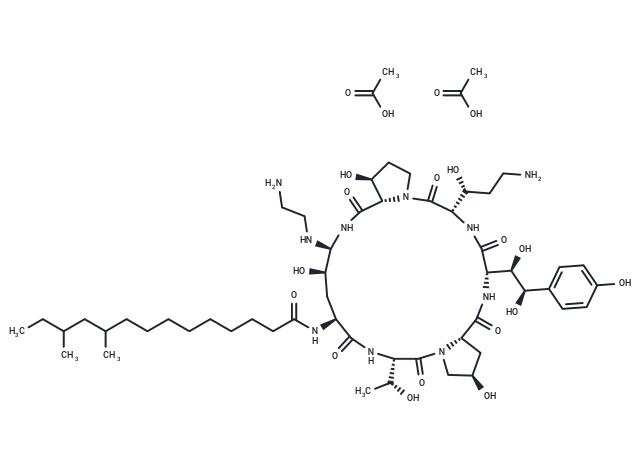Shopping Cart
Remove All Your shopping cart is currently empty
Your shopping cart is currently empty
Caspofungin Acetate (MK 0991) is the acetate salt of an antimycotic echinocandin lipopeptide, semisynthetically derived from a fermentation product of the fungus Glarea lozoyensis. This agent is active against Aspergillus and Candida species.

| Pack Size | Price | USA Warehouse | Global Warehouse | Quantity |
|---|---|---|---|---|
| 5 mg | $52 | In Stock | In Stock | |
| 10 mg | $77 | In Stock | In Stock | |
| 25 mg | $157 | In Stock | In Stock | |
| 50 mg | $283 | In Stock | In Stock | |
| 100 mg | $441 | In Stock | In Stock | |
| 1 mL x 10 mM (in DMSO) | $106 | In Stock | In Stock |
| Description | Caspofungin Acetate (MK 0991) is the acetate salt of an antimycotic echinocandin lipopeptide, semisynthetically derived from a fermentation product of the fungus Glarea lozoyensis. This agent is active against Aspergillus and Candida species. |
| In vitro | Caspofungin acetate is the first in a new class of antifungals that inhibits the synthesis of beta (1, 3)-d-glucan, an essential component of the cell wall of filamentous fungi. Prior studies have shown in vitro activity of caspofungin acetate using the reference methods, broth microdilution or macrodilution, for antifungal susceptibility testing of Candida species established by the National Committee for Clinical Laboratory Standards 1997 guidelines against a variety of Candida species including Candida krusei. Although caspofungin acetate is only Food and Drug Administration-approved for the treatment of aspergillosis, there is information showing that many Candida species are susceptible. The minimal inhibitory concentration for 90% inhibition of Candida species by caspofungin acetate are as follows:C. albicans 0.5 μg/mL (range, 0.25-0.5), C. glabrata 1.0 μg/mL (range, 0.25-2.0), C. tropicalis 1.0 μg/mL (range, 0.25-1.0), C. parapsilosis 0.5 μg/mL (range, 0.25-1.0), and C. krusei 2.0 μg/mL (range, 0.5-2.0) |
| In vivo | Mice injected with caspofungin at vitreal concentrations from 0.41 to 4.1 μM cause no significant alterations in their ERG waveforms and their retinas have no detectable morphologic changes or loss of cells. At the vitreal concentration of 41 μM, caspofungin reduces the amplitudes of the a-waves, b-waves, and scotopic threshold responses of the ERG and also produces a decrease in the number of cells in the ganglion cell layer[4]. Caspofungin (8 mg/kg) or amphotericin B at 1 mg/kg given i.p. once daily for 7 days beginning at 30 h after infection resulted in 100% survival through day 28 relative to vehicle control treatment, which results in 100% mortality by day 11 after infectious challenge. Caspofungin reduces recovery of viable Candida from kidney and brain tissues compared to vehicle control treatment on day 5, when control burden peaked. Caspofungin-treated mice dosed with 2 mg/kg or greater have significantly lower brain burden than amphotericin-B-treated mice at day 5. Amphotericin B and caspofungin treatment reduce kidney fungal burden by 1.7 log CFU/g and 2.46 to 3.64 log CFU/g, respectively[5]. |
| Synonyms | MK 0991, L 743873, L 743872, Cancidas |
| Molecular Weight | 1213.42 |
| Formula | C56H96N10O19 |
| Cas No. | 179463-17-3 |
| Smiles | CC(O)=O.CC(O)=O.CCC(C)CC(C)CCCCCCCCC(=O)N[C@H]1C[C@@H](O)[C@@H](NCCN)NC(=O)[C@@H]2[C@@H](O)CCN2C(=O)[C@@H](NC(=O)[C@@H](NC(=O)[C@@H]2C[C@@H](O)CN2C(=O)[C@@H](NC1=O)[C@@H](C)O)[C@@H](O)[C@H](O)c1ccc(O)cc1)[C@H](O)CCN |
| Relative Density. | no data available |
| Color | White |
| Appearance | Solid |
| Storage | keep away from direct sunlight,store at low temperature | Powder: -20°C for 3 years | In solvent: -80°C for 1 year | Shipping with blue ice/Shipping at ambient temperature. | ||||||||||||||||||||||||||||||
| Solubility Information | DMSO: 102 mg/mL (84.06 mM), Sonication is recommended. H2O: 100 mg/mL (82.41 mM), Sonication is recommended. | ||||||||||||||||||||||||||||||
| In Vivo Formulation | 10% DMSO+40% PEG300+5% Tween-80+45% Saline: 3.3 mg/mL (2.72 mM), Sonication is recommeded. Please add the solvents sequentially, clarifying the solution as much as possible before adding the next one. Dissolve by heating and/or sonication if necessary. Working solution is recommended to be prepared and used immediately. The formulation provided above is for reference purposes only. In vivo formulations may vary and should be modified based on specific experimental conditions. | ||||||||||||||||||||||||||||||
Solution Preparation Table | |||||||||||||||||||||||||||||||
H2O/DMSO
| |||||||||||||||||||||||||||||||
| Size | Quantity | Unit Price | Amount | Operation |
|---|

Copyright © 2015-2026 TargetMol Chemicals Inc. All Rights Reserved.